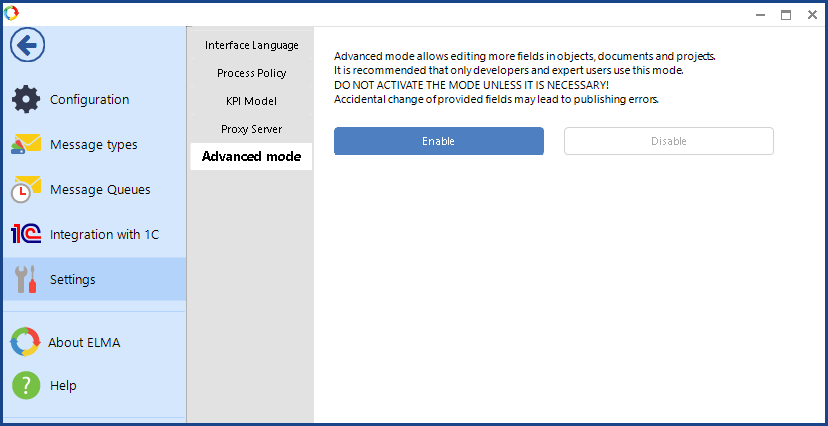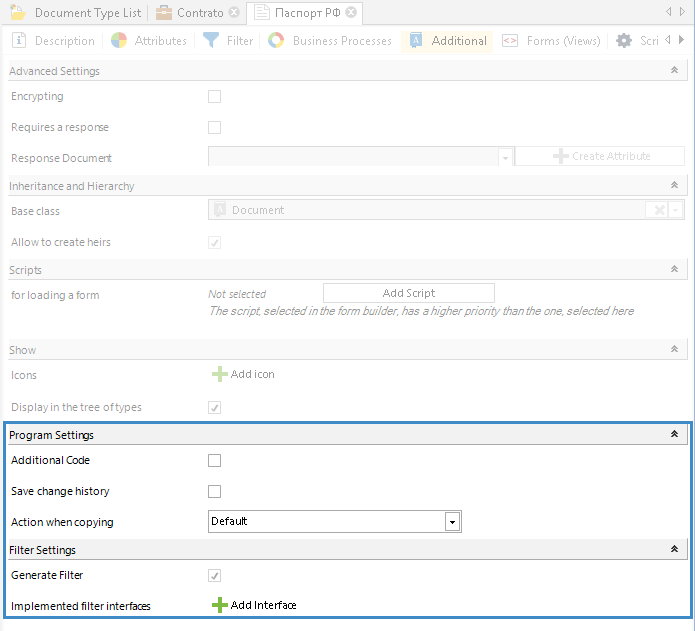|
Attention!
The information in this article is only relevant for ELMA 3.11.5 and higher.
|
The advanced mode - in this mode all the advanced settings of the objects, document types, record cards and project types become visible and available for editing. Advanced settings will be also available on the form for creating a new project type, document type and record card. It is recommended that only developers and experts use this mode. Accidental change of provided fields may lead to publishing errors.To enable/disable the advanced mode, go to ELMA Designer - Menu - Settings - Advanced Mode (fig. 1). By default, this mode is disabled.
|
|
|
Fig. 1. ELMA Designer > Menu > Settings > Advanced Mode
|
When you click the Enable button, a warning window opens (fig. 2). Click OK to confirm your action.
Once you have enabled the advanced mode, the additional settings will be available for editing in:
Objects
On an object page, the Additional Tab features the following additional settings: Program Settings and Filter Settings (fig. 3).
|
|
|
Fig. 3. Custom object page. Additional Tab.
|
Implemented interfaces - allows adding an implemented interface. In the dialog box, enter the full name of the interface type and click OK to confirm.
Additional code - allows writing program code. When you select this checkbox, the
Additional Code tab opens.
Enable cashing - enable caching to speed up access to an object in Web Application.
Save change history - allows saving the history of changes of object instances in a service table.
Support export/import - an object acquires the UID property that enables object import and export from one
system configuration to another, databases, etc.
Action when copying - select an action that will be applied to
object properties when copying the object. This is applicable to copying objects in
scripts.
As an example, consider copying the Contact object that contains the Contractor property of the Contractor type.
Save the source link - a new object is not created, but a link to the source object and its properties is provided.
Always copy through link - a new
object and its
properties will not be created. The copy will link to the original object
properties. Suppose, there is a Contact object that contains a reference to the Contractor object in the Contractor field. The copy of the Contact object will link to the same Contractor object as the original.
Always create link - a full copy of the object and its properties is created. For example, a new Contact object and a new Contractor object will be created. The link in the Contact copy refers to a copy of the Contractor object.
Do not copy - Create a new
object without copying the
properties of the original. For example, a new Contact object with an empty Contractor field will be created.
Generate filter - customize the display of the
Advanced Search button in Web Application for instances of the current object, i.e. enables the
advanced search functionality, including
filters. When the checkbox is selected, the Filter tab is added to the object page, on which a filter is configured. The filter includes the object properties, for which the
Participates in the search (filter) parameter is enabled.
Implemented filter interfaces - the ability to add an implemented filter interface. In the dialog that opens, enter the full name of the interface type and click OK.
|
|
|
Fig.3 Custom document type page. Additional Tab.
|
The
Program Settings and
Filter Settings sections of a Document type page are similar to those of an
Object page. However, the
Document type page does not include such settings as:
Implemented interfaces,
Enable cashing and Support import/export, also, the generate
Filter settings is not available for editing.
Record Card Page
Project Type Page
Copyright © 2006–2019 ELMA




